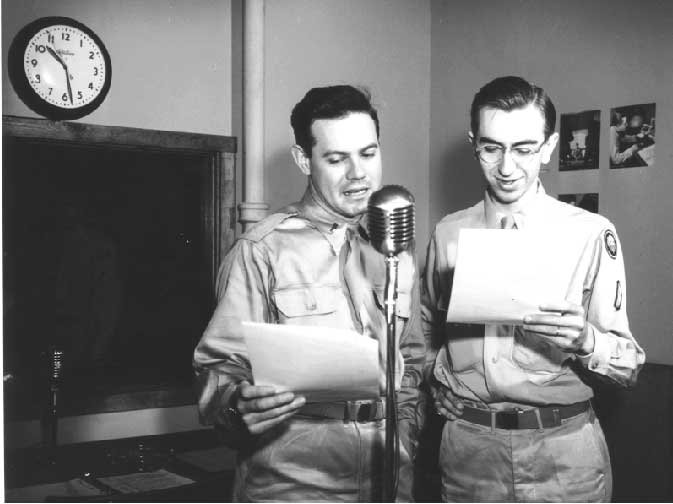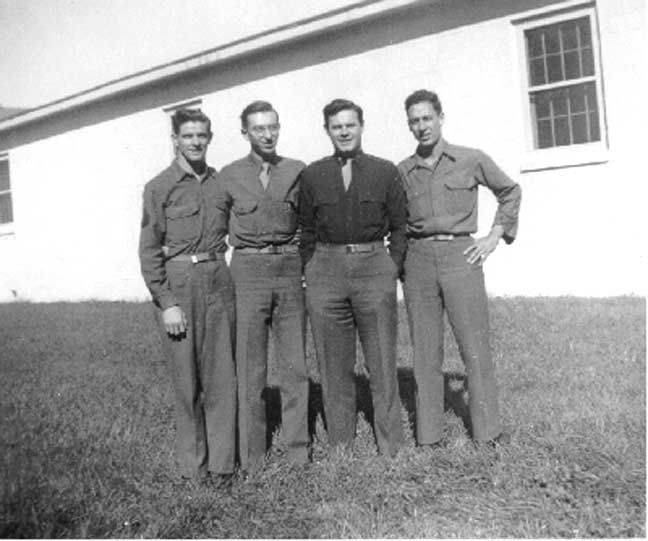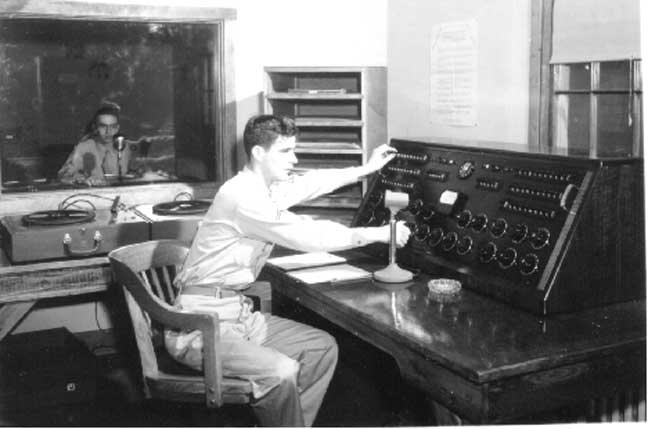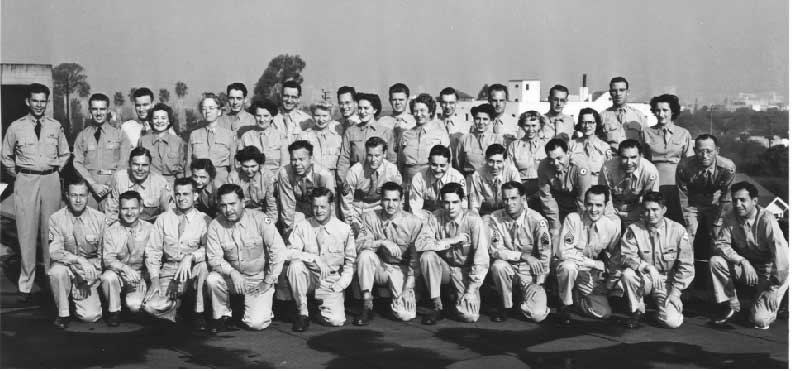|
W. A. K. E |
|
August
15, 2001 The
Story of W.A.K.E.
By
Bob Donaldson "This is W.A.K.E., Wakeman General Hospital Radio, an affiliate of the Armed Forces Radio Service. We open our broadcast day with a message from Chaplain - - - - - - - with our thought for the day."
Our
regular broadcasting day began at 11:00 AM to 4:30 PM and 6:00 PM to 9:15
PM (lights out) weekdays and Sundays 1:00 PM to 5:00 PM and 6:00PM to 9:15
PM. We provided radio program
material both local and recorded from the Armed Forces Radio Services such
as Command Performance, Mail Call, G. I. Jill, G. I. Journal, and Words
with Music. AFRS provided
script material for local production and an extensive music transcription
library on 16 inch, 331/3-RPM discs that were updated with new music on a
monthly basis. We also
received the famous V-Discs from Special Services and standard 78RPM
records from the major record companies.
Every broadcast day ended with the National Anthem.
W.A.K.E.
Radio produced local interviews with the hospital staff and the Patients. I made disc recordings on a portable Presto disc “cutter”
of these interviews that were sent to Commercial radio stations nearest a
Patient’s home to let the Patient’s relatives and friends know how the
Patient’s was recovering at Wakeman.
Other local programs included music groups from the surrounding
Indiana towns of Edinburg, Columbus and Indianapolis as well as the Camp
Atterbury Army Bands. Whenever
we had visiting celebrities we interviewed them for broadcast or if there
were stage shows of any kind we had remote microphone “feeds” to our
control room to in turn broadcast the shows to the Hospital Wards.
W.A.K.E.
provided Hospital, Local, National and World News provided by various News
services by Teletype, including the Indianapolis Newspapers.
We ran our programs as any Commercial Broadcast Station does theirs
but aimed at the varied taste of the patients.
When
we inaugurated broadcasting, June 1945, we had our studio, control room
and office, known as The Radio Room, located on the second floor of
Building 1030 near the Conference Room.
The Studio and Control Room were sound proofed with a
double-glassed window between the Studio and Control Room.
The doors had to be double insulated with special weather stripping
to reduce any extraneous noise.
Our
staff was small. It included
Station Manager, Lt. Earle H. “Bud” Gillis, Danville, Ill., Program
Manager/Announcer/Station Engineer, Pfc. Robert “Bob” W. Donaldson,
Buffalo, NY; and Technician/Operator,
Pfc. Harold L. Bailey, Grand Marais, Mich.
Later, in July, we were fortunate to add a fourth member,
Producer/Announcer, Pfc. Charles “Guggie” Guggenheim.
In July, Lt. Gillis attended AFRS School in Hollywood, and Pfc. Bob
Donaldson attended in August. Unfortunately, the other members of our staff were unable to
attend. The AFRS School held
classes in every phase of radio broadcasting including “hands-on” work
helping in the production of the Command Performance, Mail Call and other
AFRS shows.
I had the assignment of timing one of the Command Performance show’s segments, songs, skits, etc. I had the pleasure of meeting Lauren Becall and Humphrey Bogart, Victor Borge, “Music Man” Major Meredith Wilson, head of the AFRS 200 musician Orchestra, capable of any musical configuration needed, the unpleasure of meeting the temper of Frank Sinatra, and many other wonderful performers on AFRS Programs. The experience at W.A.K.E. held me in good stead, because when I was discharged in February 1946, on points, I was able to get a job in Broadcast Radio in Montgomery, Alabama, and when I returned to College at Auburn University in 1949, I worked for the local Broadcast Station to augment my G. I. Bill income until I graduated in 1952 in Electrical Engineering. I spent my career with Westinghouse Electric Corporation in Electronics Engineering and Management until my retirement 35 years later. Unfortunately, I do not know the further careers or whereabouts of Lt. Gillis or Pfc. Harold Bailey, after release from the service. But, Pfc. Charles “Guggie” Guggenheim who lives in Washington, D.C., has become famous as a documentary filmmaker receiving 12 Academy Award nominations over the years.
A
story of W.A.K.E., written by Lt. Bud Gillis with contributions from Bob
Donaldson, appeared in the Wakeman PROBE newspaper on June 14,
1945.
There
is more to the beginnings of W.A.K.E. than that which appeared in the PROBE.
As the article indicated, the Business and Professional Women’s
Club of Muncie, Indiana donated the Radio system.
The Club’s War Activities Committee raised the funds to build the
system by sponsoring two theater productions in Muncie.
The
Club received approval by the Hospital Administration in late 1944 and
engaged Bell Sound Systems Company (not a part of the Bell Telephone
System) in Indianapolis to design a closed circuit audio broadcast system.
The design, which fit the budget, was a one-channel system, which
used loud speakers in each ward and one in the nurse’s office.
The nurse’s office could select whether or not the ward speakers
were ON or OFF, and the loudness. The
Nurse’s Office had a separate speaker that could not be turned off,
because a separate part of the system was a Public Address system with
speakers in the halls of the Hospital used to locate the Medical Staff.
The Control Room of W.A.K.E. could take control and override the
complete Radio and Public Address system for announcements in case of an
‘emergency’. When
W.A.K.E. was quiet, we patched in the Commercial Radio Station, WIRE, and
Indianapolis, which was connected to the System via a Radio Tuner in the
Control Room.
This
was the day of vacuum tubes. The Hospital was divided into four sections.
One of four high power vacuum tube audio amplifiers were connected to each
section from an Amplifier Room located near the center of the Hospital.
The program signal from the Control Room was sent by audio cable to the
Amplifier Room. All audio and control of program signals and the Public
Address system were controlled through the Control Room at The Radio Room.
The separate Public Address power amplifier for the hall and
nurses’ speakers also was located in the Amplifier Room with an
auxiliary pre-amplifier and switched microphone located at the Hospital
Central Entrance Desk. The
control, however, was routed through The Radio Room control console.
When
the Bell Sound installation people arrived on scene, they requested
temporary help from the Hospital staff.
No staff personnel were available, but I had been teaching high
school subjects with the Educational Reconditioning Staff while recovering
from a complicated broken ankle surgery.
I had received the broken ankle while on maneuvers with the 106th
Infantry Division prior to the Division leaving Camp Atterbury for
overseas duty. I was one of the ASTP Engineering students sent to the 106th
from Auburn University (then known as Alabama Polytechnic Institute), and
I had had Infantry Radio Repair School, was assigned to Radio Repair with
the 106th, 423rd Regiment.
My name was submitted and accepted for the job of helping to
install the audio sound broadcasting system.
The Bell installers needed a second person.
I knew Harold Bailey and his qualifications as a technician and we
were both “hired” as installer helpers.
Both of us were classified for ‘limited’ duty, and also became
part of the staff of W.A.K.E. when the installation was completed and the
system dedicated.
Harold
and I had to ‘drag’ and installed miles of cable and wiring through
the halls and into the wards, private rooms, and nurses’ stations of
Wakeman. The cables were
installed under the hall floors and in crawl spaces.
In certain wards we had to have MP’s guard us until the
installations were complete and we had to use metal conduit to protect the
wiring because of the type of condition of the patients.
The ward speakers were mounted on the vertical ceiling support
beams, high enough to prevent anyone from interfering with the speakers
without a ladder. Most cables
and wiring had an outside braided shield covered with an insulation
material. The shield was grounded to prevent extraneous hum and electrical
noise from interfering with the control and low level audio signals. W.A.K.E. became less and less operational after the Japanese surrender and our military personnel were discharged under the point system. Those of us still in service after 1945 were wooed with promises of either large promotions in rank, Officer Candidate School, or equivalent Government GS ratings if we would stay. It was a difficult decision, but most of us were civilians at heart. I wanted to return to civilian life. I was married with one child, and I wanted to eventually complete my College education under the G. I. Bill. And I did. The story of W.A.K.E. could be expanded upon with personal anecdotes and service stories, but I leave the Service stories to the heroes of WWII. As a member of the 106th Infantry Division Association, I feel that the stories I read of the valiant heroes of the Battle of the Bulge are far and away the real stories, but I feel that the “The Radio Room Four” who operated W.A.K.E. were to some degree heroes too who brought some entertainment and a bit of civility to those wounded G.I.’s returning from the hell of combat. So, this is W.A.K.E., Wakeman General Hospital Center, signing-off for the last time.
Robert
W. Donaldson, Jr. |
|
click on images for
larger view All photos courtesy of Mr. Bob Donaldson
Armed forces Radio Service School |

Armed Forces Radio Station - Wakeman
General Hospital |

Staff of W. A. K. E., the wired Radio
Station at |

W. A. K. E. Control Room - June 1945 |
|
History of Radio Station WAKE W*A*K*E* was what today would be called "Closed Circuit" Radio in that the signal was pure audio and did not radiate as a radio signal. The System eventually was to have at least 5 channels available, but we has just 2, one was from our studio and control room, and included Armed Forces Radio Programs provided on 16 inch disks at 33 and 1/3 RPM and our own locally produced programs. The second channel was a rebroadcast of WIRE, the NBC broadcast station in Indianapolis. We had hard-wired speakers with "pad type" volume controls, two in every ward and one in every Nurse's Office (Station). The Channel switch was located in the Nurse's Station. So the Patients had to agree to what the majority wanted to listen to. In the private Patient's Room we used Pillow speakers. The intent of the eventual system, however, was to have Pillow Speakers with a channel switch and volume control for each bed, but money and time ran out; the war was over. The system was financed by private money. There was also a Public Address System from the Hospital Information Desk which had a speaker in each Nurse's station and in the Halls. I'm trying to recollect if the PA System could capture the Program System. I don't believe it could. Information supplied by Robert W. Donaldson |
Earle H. "Bud" GillisProcessed by: Karen E. King,
Bryan E. Cornell, February 1993 Radio announcer and executive Earle H. "Bud" Gillis, Jr. was born on December 27, 1919 in Danville, Illinois. He attended elementary and secondary schools in Danville, before enrolling at the University of Illinois to work on a B.A. in speech. After his graduation in 1941, Gillis spent the following two years as a radio announcer. He was chief announcer at WDAN radio in Danville and he was staff announcer in Evansville, Indiana for WGBF radio. Following this initial work in radio, Gillis entered the military and became a Second Lieutenant in the Army's Medical Administrative Corps. In the Army he was able to use his knowledge of radio to announce and to help construct and manage a hospital broadcasting system in Wakeman General Hospital, Camp Atterbury, Indiana. In December of 1946, Gillis returned to civilian life as an announcer and newscaster for WHKC Radio. From 1953 to 1962 Gillis was Program Manager for WLWC/Channel 4 where he supervised all programming, coordinated program schedules with NBC, and handled on-air talent. From 1962 to 1970, Gillis served as Executive Secretary for the Ohio Educational Television Network Commission. Here, Gillis helped construct and operate a statewide television network that greatly increased the number of viewers in Ohio. By 1969, the Ohio General Assembly was willing to authorize more than $5.5 million for the network. In the 1970's Gillis held a variety of jobs in broadcasting. Between 1970 and 1971, he helped produce mobile color remote television as an administrative assistant to the President of the RME Group of Communications Companies. Between 1973 and 1976 he was a TV commercial announcer for the Big Bear Supermarket Chain. During this period he also worked for the Ohio Department of Education from 1971 to 1975 as an educational consultant. At this job he coordinated a newly formed educational media center, assisted the Superintendent of Public Instructions, supervised special projects, and acted as the publications review specialist. From 1975 until his retirement in 1988 Gillis was Vice President of development for WCET in Cincinnati, while also acting as "Uncle Bud" for children's programs. |
|
The Franklin Evening Star - 29
March 1945 |
|
© 2007 James D. West - Indiana Military Org
All Rights Reserved
Page Last Revised 09/08/2013 |
